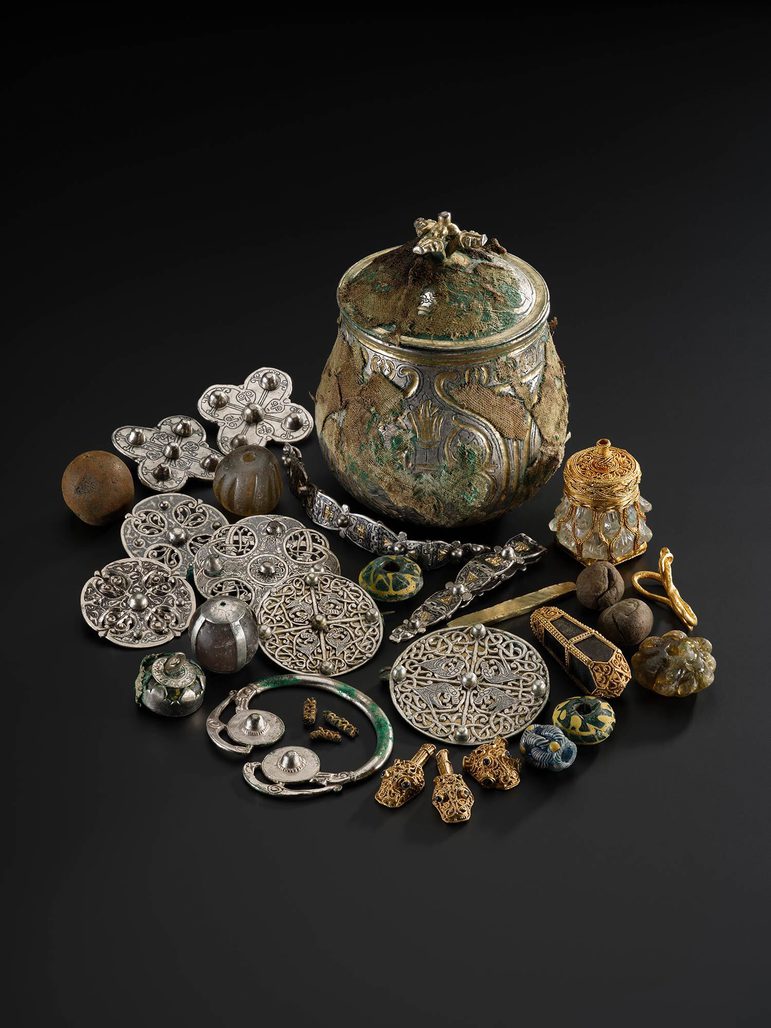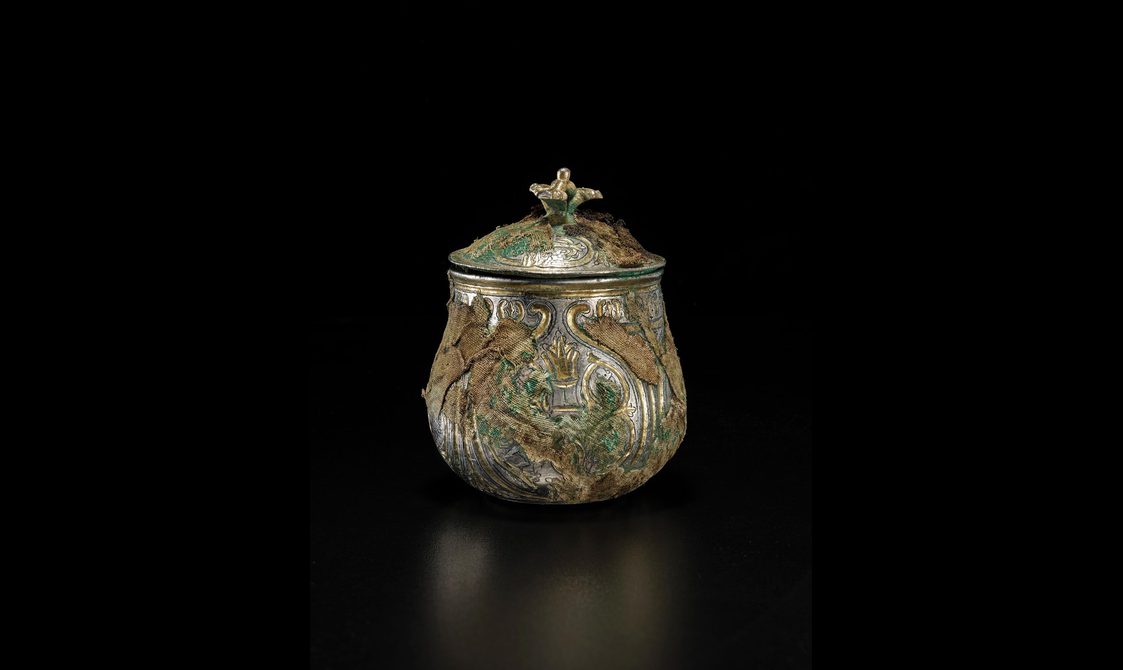
A treasure in its own right: The Galloway Hoard vessel
News Story
The lidded vessel which contained the Galloway Hoard's most precious treasures is a revelation. For the first time in over a thousand years its distant origins and incredible journey have been brought to light by expert conservation and cutting-edge research.
The lidded vessel in the Galloway Hoard is like a hoard within a hoard. It was carefully packed to the brim with 27 objects. But the vessel was more than just a container. It was a treasure in its own right.

The lidded vessel from the Galloway Hoard and the Viking age treasures it contained.
First glimpses
Thanks to painstaking conservation work, we know that most of the objects in the Galloway Hoard were deposited in the ground wrapped in textile or leather. Organic materials such as these do not usually survive for long once they are buried. Thankfully, the silver vessel and its lid have helped preserve large parts of the original wrappings. These presented a conservation challenge, but also an opportunity for kinds of scientific analysis that would not be possible on inorganic materials like metal.
Once exposed to the air, the fragile textiles of the Galloway Hoard vessel began to decay more rapidly. They were quickly stabilised by the artefact specialists at AOC Archaeology, who undertook the first inventory of the Hoard. CT scans and X-radiography were then used to examine the vessel without disturbing its wrappings. This gave us a three-dimensional view of the vessel's surface and its contents.

Digital image of the Galloway Hoard vessel based on CT and X-ray scans.
These first glimpses transformed our understanding of the vessel. This is only the third decorated silver-gilt vessel to be found as part of a Viking-age hoard in the UK. The suggested origin of the other two is the Carolingian (Holy Roman) empire of continental Europe based on surface decoration similar to Christian manuscripts. However, the 3D X-ray scans of the surface of the Galloway Hoard vessel revealed something quite different. Leopards, tigers and Zoroastrian religious symbols suggested that the Galloway Hoard lidded vessel was a piece of Central or Western Asian metalwork. Zoroastrianism was the state religion of the Sasanian Empire (AD224-651) centered on what is now Iran.
Tigers and leopards often featured in hunting scenes on silverware from the Sasanian Empire. Within each roundel on the vessel surface is a Zoroastrian fire-stand, an important feature of Sasanian imperial iconography, also found on their coinage. It is remarkable to find one of these eastern vessels so far to the west, thousands of miles from where it originated.

Reproduction of the vessel.
Unwrapping and lasers
Once carefully emptied of its contents, conservation could turn to the lidded vessel itself.
Conservation of the vessel presented several challenges. Although predominantly made of silver, its surface was almost entirely covered by both large areas of the original textile wrappings of linen and wool, and by a layer of green copper corrosion which had formed over the silver during its time buried in the ground.
We wanted to preserve as much as possible of the textiles wrapping the vessel, as these give us rare insights into the materials themselves, but also their use and importance in the history and treatment of the object when it was buried over a thousand years ago. However, we also wanted to remove the green copper corrosion products where these obscured areas of the original surface not covered in textiles. This would reveal the decoration in more detail and expose the original colours and techniques used on the vessel.
To do this we decided to remove corrosion from the silver surface using a laser cleaner. The very intense, pure and directional light of the laser allowed much of the copper corrosion to be removed, without damaging the silver decorated surface. The very fragile textile was also protected as there was no chemical cleaning involved, and very little physical contact when using the laser beam.
The results mean that the original textile is preserved in place, but more areas of decoration on the silver-coloured surface can be seen, highlighted by gilding and niello (a black silver sulphide inlay). The black inlay contrasts with the bright silver and is used to enhance features, such as the stripes and spots on the animals.
The vessel before and after conservation

The Galloway Hoard lidded vessel before conservation. Museum reference X.2018.12.71.

The lidded vessel from the Galloway Hoard.
Silver analysis
With the exotic imagery on the lidded vessel now fully revealed, the question remained about its origin. We were lucky to partner with a major European Research Council-funded project based at Oxford University, ‘fingerprinting’ the sources of the silver found in Viking-age hoards. This project had already transformed our understanding of the Galloway Hoard by showing that most of the hacksilver was made from melted-down Anglo-Saxon and Anglo-Scandinavian coins and metalwork.
A variety of techniques (XRF, laser ablation and lead isotope analysis) were used to examine the chemical composition of the silver and we began narrowing down possible sources. The silver was mixed with almost pure copper, a composition typical of Sasanian silver, but not contemporary European silver. But the clearest indication of origin came from testing the black niello inlay, which also contains silver. The result of this confirmed a very precise origin from the silver mine of Nakhlak in central Iran.
Image gallery

The lidded vessel from the Galloway Hoard. Image: National Museums Scotland

The lidded vessel from the Galloway Hoard. Image: National Museums Scotland

The lidded vessel from the Galloway Hoard.

The lidded vessel from the Galloway Hoard.
More than a treasure
So much of the Galloway Hoard research has been a journey into the unknown. Given that there have been other vessels of similar size and shape used as Viking-age treasure containers, we were not initially expecting that this vessel would be so different from the others. But as soon as we saw the first scans of the decorated surface the challenge was set to identify why this vessel looked so different.
Confirming an origin in Western Asia through scientific analysis still leaves us with important questions.
When was it made? What was it used for before it became a treasure container? How had it traveled halfway around the known world to reach southwest Scotland? The vessel contains Scotland’s earliest examples of silk, and these too must have travelled a similar distance. The combination of a distant origin with some unusual contents, including heirlooms and relics, separates the Galloway Hoard even further from any stereotype of what we might expect a Viking-age hoard to contain. More than just a treasure, the vessel contained an important family’s history told through their most precious objects.
The Galloway Hoard has given us a glimpse of a more interconnected Medieval world than we ever expected, and Scotland’s place within it.


